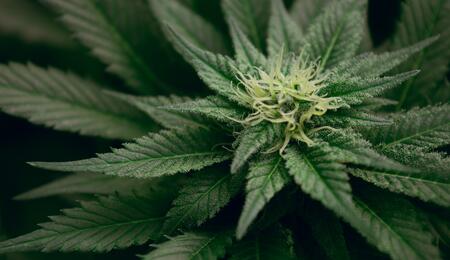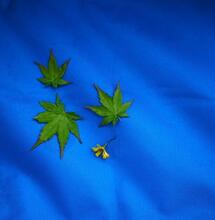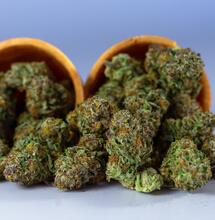Richard Davis of the USA Hemp Museum

A few hundred yards from the Staples Center, and the swirling hive of the new downtown LA, lies (believe it or not) the biggest treasure trove of hemp artifacts in the world. Just across the train tracks and down Flower Street, in a nondescript warehouse, USA Hemp Museum curator Richard Davis has assembled his life's work: hemp.
In fact, you may have seen him driving around town in his maroon Honda, adorned with a massive hemp bushel atop it like some sort of automobile reindeer, and the blaring HONK IF YOU LOVE HEMP stickers splattered everywhere. "Yeah, you can't miss the car," Davis tells me, his Indiana Jones-like fedora and urban-jungle outfit giving him the look of a modern day Romancing the Stone-type figure. "Oh, look at this - it's a Bible made from... hemp!" Yes, the 8,000-square-foot warehouse is stuffed: posters, books, soap, food, literature, elixirs, flags, shoes, cereal, magazines, shirts, pants, suits... well, almost anything you can imagine - and all made from hemp.
The boats that discovered the West were sailed with hempen rope; the prairie wagons that rambled across America were covered with hemp canvas. Kentucky, Missouri and Wisconsin farmers grew acres and acres of hemp on their rich, well-drained soil, planted like fields of corn all the way to the sunset - the August and September harvest being so plentiful that party celebrations were always in order. In a glass display case an old copy of Popular Mechanics magazine declares on its cover that HEMP IS A MIRACLE CROP and, a few displays down, a short video declaring that the parachute George Bush used during WWII was made from hemp rope.
As we toured the museum the soft-spoken Davis, who is also the author of three books on hemp(Hemp for Victory, A Global Warming Solution and The Trillion Dollar Crop) offers me a hemp milkshake ("I make them every day"), some green paste in a small jar ("This will help your mom's arthritis... I make this on my farm; hemp oil lotion is very effective for many ailments"), and his very own honey-roasted hemp nuts, which he is currently pitching to Alaska and Southwest Airlines to carry on their planes as nutritious snacks. After the tour was over we sat down for a chat - and, well, a real education.
WHERE DID YOU GROW UP?
Richard Davis: I was born in Phoenix, Arizona. My Dad was a Methodist preacher so we moved somewhere in Southern California or Arizona every four years. Some of the towns were Gilbert, Ajo and Willcox in Arizona, and Paso Robles and Yorba Linda in California.
WHEN DID YOU FIRST HEAR ABOUT MARIJUANA?
RD: In Yorba Linda, which is Orange County, California; friends of my older brother were busted for pot. I was maybe fourteen years old. I had the same job as Richard Nixon had: mowing Mrs. Pickering's lawn.
WHEN DID YOU FIRST SMOKE CANNABIS?
RD: I joined the Air Force right out of high school in Willcox, Arizona, and started taking college courses at night. After four years of the Air Force, I went back to school full-time and graduated with a Bachelor's Degree in Zoology at Cal State U in Los Angeles (CSULA). I was working on my Master's Degree in Biology when I met my future wife, who turned me on to pot. I didn't drink for eight years because I hated to get sick. Here was a smoke that didn't get me sick and had no hangover. Cannabis changed my whole life. It was the 60s, and I became a long-haired hippie feminist while attending the School of Public Health at UCLA. In 1972, after becoming a Doctoral Candidate, I took a leave of absence and never went back. I moved to Mendocino County and began to grow Cannabis.
AT WHAT POINT DID YOU LEARN ABOUT HEMP, AND THAT IT CAME FROM THE SAME PLANT?
RD: I learned about hemp in 1990, after almost twenty years of growing pot. I was already an activist in the pot movement, having run for Congress from the First District in Northern California as an admitted pot grower in 1985-86. I lost, but being out there in public probably kept me out of trouble. I met Jack Herer, author of The Emperor Wears No Clothes, at a demonstration against the Army being used against citizens in the King's Range of Humboldt County in 1990. He sold me two copies of his book on hemp. I knew hemp; I had been growing it for twenty years. I read his book twice in two days.
WHEN DID YOU START INVESTIGATING THE USES OF HEMP?
RD: I needed little investigation to figure out I had been lied to and deceived about hemp. I knew how fast hemp grows. I had the resource at home and didn't know what I had until I read the book, really.
WHEN DID YOU START COLLECTING HEMP MEMORABILIA AND TURN IT INTO YOUR LIFE'S MISSION?
RD: I am a scientist, who had worked in the school museum at CSULA. The museum idea took about a week, after Jack's book in 1990. The first item from outside the farm was neighbor Bill Griener's grandfather's forty-five star US death flag for being a Spanish-American War Veteran. These flags are traditionally flown over the US Capitol. The late Bill donated it to the museum effort. All made from... hemp.
WHAT HAVE BEEN SOME OF THE USES FOR HEMP THAT AMERICA HAS SEEN IN THE PAST?
RD: More books should be written and many more corrected about the history of hemp. The time of early America could be called the age of hem. We grew hemp to supply the Navy and Army clothes in a war that won us our independence from Britain. Every farm grew hemp for homespun cloth or to pay taxes, or for rope, paper, sails, tents, etc. The paper on which our laws were written was hemp paper. And hemp was the first true pulped paper in China some 2,000 years ago.
AND BIBLES....
RD: The hemp museum has three hemp paper Bibles. The oldest is a hemp rag bond Bible from England in 1830; I picked it up in a San Francisco library book sale for $4. Remember, Bibles used to have this ultra thin crisp paper? That was hemp paper. Great paper.
HOW DID THE MUSEUM COME ABOUT, AND WHAT ARE SOME OF THE MOST SURPRISING ITEMS YOU HAVE IN THE MUSEUM?
RD: The USA Hemp Museum started as the Mendocino Mobile Marijuana Museum, a play on the fact that the US Government calls all Cannabis the misleading marijuana word. Hemp is the correct common term for the Cannabis plant, there being only one species. The museum was invited to the first Hemp Expo at the Los Angeles Convention Center by Brian Roberts. He allowed me to spread out the museum for the first time. Now we have 38 display cases and ten tables of hemp, hemp history, hemp products and hemp collections, including books, magazines, stickers, buttons, patches, belt buckles, roach clips and jewelry.
I call them the rooms of the museum, which include agriculture, history, bio- fuels, textiles, food, rope and twine, medicine, plastics, building materials, paint and varnish, recreation, religion, economics, environment, legal, library and hemp heroes. Some of the neat things are a page of hemp paper from 1,496 AD, a board with samples of 99 different kinds of hemp fabric from China, a vintage Civil War can of varnish from the Pittsburgh Plate Glass Co. (the varnish is still good!), the medical display; and the varnish, paper, press board, boxes, and hempcrete (hemp concrete) that I make. A very effective and very durable and environmentally friendly alternative to concrete. Hempcrete is carbon negative. Like other plant products, the hemp crop absorbs CO2 gas as it grows, retaining the carbon and releasing the oxygen. They are using it to build houses in Asheville [NC] - even the Mayor had his house built from it!
HOW MANY ITEMS DO YOU HAVE?
RD: I haven't counted, but thousands of items, for sure, not counting boxes of papers and magazines not yet cataloged and displayed. This collection is the result of twenty years of being aware and not letting anything hemp past my eye. I've scoured flea markets, yard sales, antique stores, hemp rallies - and friends have all contributed to the collection.
YOU ARE ALSO A FARMER AND CREATE HEMP OIL FOR MEDICINAL PURPOSES AND HEMP FOOD/DRINKS?
RD: I have heard it from all the experts: hemp seed protein and hemp seed oil are excellent foods. The protein is easily digestible and the oil is like fish oil, very high high in Omega 3 fatty acids that clean your arteries and veins, with other fatty acids - in a perfect blend for humans - and seal your cells from virus invasion. Less meat, more hemp. Less meat, more water to grow hemp.
WHAT IS THE MAIN IMPEDIMENT TO BRINGING BACK THE HEMP INDUSTRY AND CREATING ITEMS AND A BRAND NEW INDUSTRY THAT COULD PUT FARMERS BACK TO WORK, ETC.?
RD: One of the main impediments to free market hemp is ignorance. We have been lied to and deceived by the government and corporate America. Obama says he wants more science, but the science is there and he continues the war on pot and hemp. Shame on him. The government has known since 1974 that Cannabis kills cancer cells. The UN Single Convention on Narcotic Drugs, which erroneously includes Cannabis (non-narcotic), exempts industrial uses of hemp, which the rest of the world is now planting. Just pure ignorance.
WHERE DO YOU SEE THE HEMP INDUSTRY GOING IN 5-, 10-, 20 YEARS?
RD: We have a model to show how fast hemp can be incorporated into the economy. During World War II, we needed hemp for the war and in two years - the first year to grow seed - 360,000 acres were planted, mills were built, and rope and canvas were being produced. Canada, which has been growing hemp for ten years, has concentrated on seed crops for food production and it is quite a big and growing industry. In Canada, the farmers wanted hemp and they got hemp. It seems like we in the US always need a crisis to institute a new way of doing things.
WHAT OTHER COUNTRIES ARE PIONEERING THE HEMP MOVEMENT?
RD: It is hard to keep up with the international movement but Google mentions lots of companies under the global hemp industries in England, Spain and France. And China is producing a lot of paper from hemp. The Germans are doing plastics from hemp. The US is stuck in a prohibition mentality that stifles most experimentation.
FINALLY, TELL US ONE ITEM THAT CAN BE MADE FROM HEMP THAT WOULD SHOCK MOST PEOPLE?
RD: Gasoline! Oil companies have patents for processes that turn wood alcohol from hemp into synthetic gasoline. Of course, flex-fuel cars and other vehicles can run on any mix of alcohol and gasoline right now. How do we get off the fossil fuel grind? Grow hemp! I'm not kidding.



